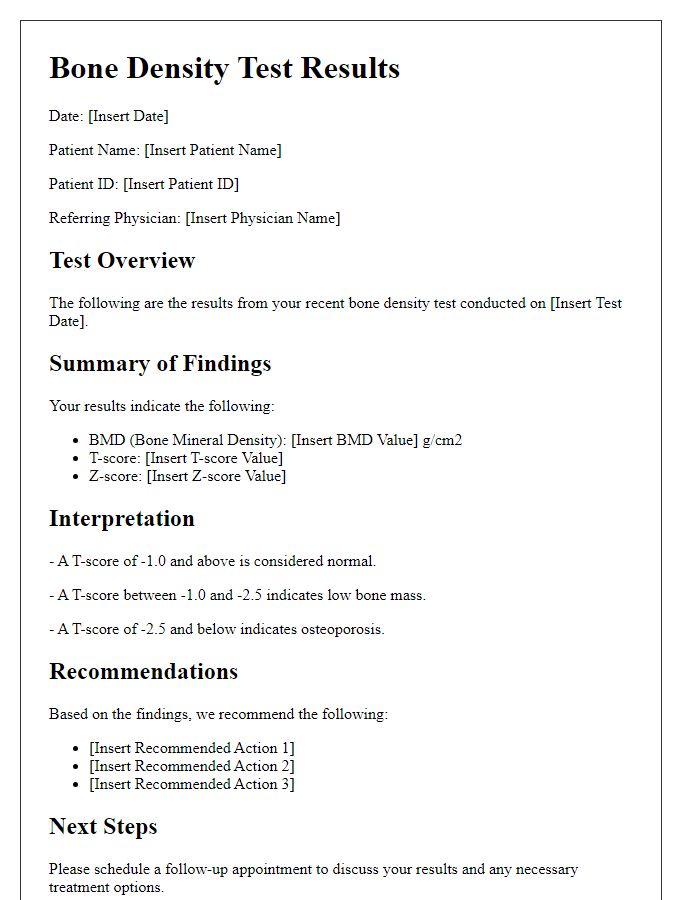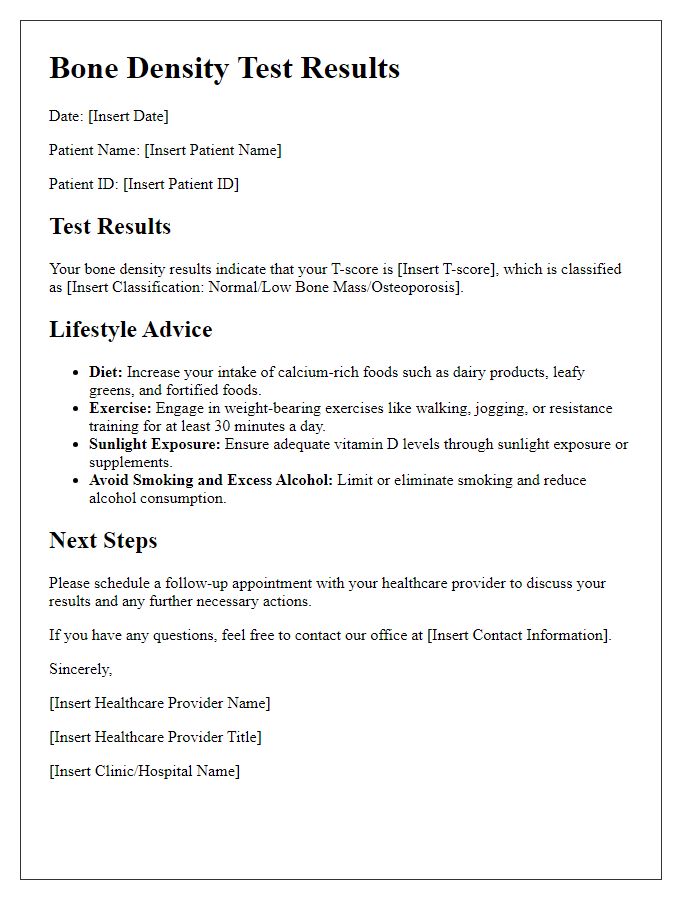Are you curious about what your bone density test results mean for your health? Understanding your bone health is crucial, especially as we age, and knowing the status of your bones can empower you to make informed decisions. In this article, we'll break down the significance of these results and offer practical advice on how to improve or maintain your bone density. So, grab a cup of coffee and join me as we delve deeper into the world of bone health!

Personal Information (Name, Date of Birth, ID Number)
Bone density tests play a critical role in assessing an individual's skeletal health, with results helping to diagnose conditions like osteoporosis. The test typically measures bone mineral density (BMD) in key areas such as the hip and lumbar spine using dual-energy X-ray absorptiometry (DEXA) technology. Results are often reported as T-scores, indicating how a person's bone density compares to that of a healthy young adult, with values below -2.5 indicating osteoporosis and -1.0 to -2.5 suggesting osteopenia. Personal information such as full name, date of birth (formatted as MM/DD/YYYY for consistency), and unique identification number contribute to maintaining accurate patient records and ensuring confidentiality during the reporting process.
Test Date and Location
Bone density test results demonstrate the strength and density of bone, typically assessed through dual-energy X-ray absorptiometry (DEXA) scans conducted in specialized medical facilities. Test date, such as April 15, 2023, indicates the specific day when analysis occurred. Location, like the Osteoporosis Center of New York City, provides context for where the diagnostic procedure was conducted and influences access to further bone health resources. Results are crucial for identifying osteoporosis risk and implementing preventive strategies to enhance skeletal integrity.
Bone Density Measurements and T-scores
Bone density tests assess the mineral content of bones, providing critical measurements for conditions such as osteoporosis. A T-score is utilized to compare an individual's bone density to the average peak bone density of a healthy young adult, typically around 30 years of age. This score indicates the risk of fractures and bone loss. For example, a T-score of -1.0 or higher is considered normal, whereas a score between -1.0 and -2.5 signifies low bone density (osteopenia). T-scores below -2.5 indicate osteoporosis, a serious condition that increases the likelihood of bone fractures. The test usually involves a dual-energy X-ray absorptiometry (DEXA) scan, providing precise measurements of bone mineral density at key sites such as the lumbar spine and hip, crucial for assessing fracture risk and guiding treatment decisions. Regular monitoring is essential for managing bone health, especially in populations at higher risk, including postmenopausal women and individuals over 70 years old.
Interpretation and Diagnostic Information
Bone density tests, typically performed using Dual-Energy X-ray Absorptiometry (DEXA) scans, provide critical insights into an individual's bone health by measuring bone mineral density (BMD) at key sites such as the lumbar spine and hip. Results are often reported using T-scores; values above -1 indicate normal bone density, values between -1 and -2.5 suggest osteopenia (low bone mass), and values below -2.5 diagnose osteoporosis, a condition affecting approximately 10 million Americans according to the National Osteoporosis Foundation. Additionally, aging, hormonal changes (particularly post-menopause), and lifestyle factors like smoking or excessive alcohol intake can significantly impact bone density. Recommendations for improving bone health might include increased intake of calcium (1,200 mg for women over 50, according to the Institute of Medicine) and vitamin D (800-1,000 IU for adults), along with weight-bearing exercises aimed at strengthening the skeletal system and reducing fracture risk. Regular follow-ups are crucial for monitoring changes in bone density over time.
Recommendations and Next Steps
Bone density test results indicate varying levels of bone mineral density (BMD) measured in grams per cubic centimeter, typically highlighting the risk of osteoporosis, a progressive condition affecting millions globally. Normal BMD values range from -1.0 to +1.0, while values below -2.5 signify osteoporosis, requiring immediate attention. Recommendations include dietary adjustments rich in calcium and vitamin D, along with weight-bearing exercises to strengthen bones. Moreover, follow-up testing should be scheduled every one to two years, depending on initial results and risk factors. Consultation with a healthcare provider, potentially an endocrinologist or a rheumatologist, is advisable for personalized treatment plans, including medications like bisphosphonates or hormonal therapy, to enhance bone density and reduce fracture risk.
Letter Template For Bone Density Test Results Samples
Letter template of bone density test results explaining the testing process.

Letter template of bone density test results with a summary of findings.

Letter template of bone density test results addressing low bone density.

Letter template of bone density test results for follow-up appointments.










Comments